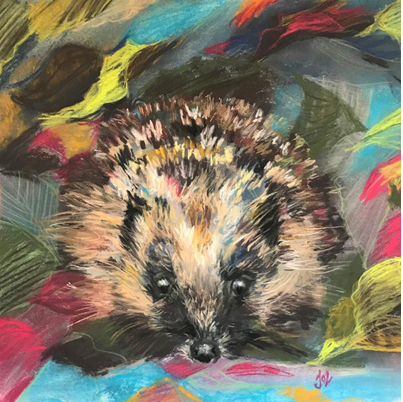Hedgehogs need our help!
The Woodcote Conservation Group invites you to help make Woodcote a great place for hedgehogs. We all know that hedgehogs are in trouble, but did you know that the UK hedgehog population has declined by a third since 2000? We know that hedgehogs can thrive in towns and villages alongside humans and that there is a lot that we can do to help right now!

Excuse me, can you help?
Hedgehog in leaves by Woodcote artist Jo Lillywhite
www.jolillywhiteart.co.uk
Hedgehogs love gardens and there are small changes that we can make to improve the lives of Woodcote’s prickly residents.
The first step is to create ‘hedgehog highways’. Hedgehogs travel about one mile each night during their active season. It is important that they can visit a wide range of gardens to forage for the slugs, caterpillars and beetles that they like to eat, or to find a mate. If your garden is enclosed, you might be getting in the way of their plans. To make hedgehogs lives’ easier, a CD case-sized hole (13 x 13cm) at the bottom of your garden fence or wall will let hedgehogs through but be too small for most pets.
Please help us make hedgehog highways around Woodcote. Have a chat with your neighbours and, with their agreement, make a hole on either side of your garden by making a small hole in your fence, removing a brick from the bottom of your wall, or digging a channel beneath your wall, fence or gate. If you’d like some help making a hole, the Woodcote Conservation Group can lend a hand – just email info@woodcotecg.org.uk. If you’ve made a hole in your garden wall or fence please visit www.hedgehogstreet.org to log it on the Big Hedgehog map.
Thank you on behalf of Woodcote’s hedgehogs (and the Woodcote Conservation Group).
jmj
10 Fun Facts about Hedgehogs
Hedgehogs are Britain’s only spiny mammal. Their closest relatives are the shrew and the mole – not porcupines, which are rodents
Just one species of hedgehog lives in the wild in Britain (Erinaceus europaeus) and there are 14 other species across Europe, Asia and Africa
Hedgehogs get their name because they love living in hedges and they make a snuffling noise like a pig as they push through the undergrowth looking for food
Hedgehogs’ spines are made of keratin, the same stuff as our fingernails and are, in effect, modified hair. Spines are around 2cm long and function as shock absorbers as well as having their obvious defensive role
Baby hedgehogs are born with spines, but their skin is inflated with fluid keeping the prickles beneath the surface. The fluid is quickly absorbed after birth allowing the spines to emerge far faster than could ever be achieved by growth
Hedgehogs are carnivores. Their favourite foods are earwigs, caterpillars, millipedes, worms and slugs
Hedgehogs are lactose intolerant, but they don’t know that, so they will drink milk even though it’s bad for their tummies
Hedgehogs are excellent climbers and can move fast for an animal with short legs. A top speed of 5 miles per hour has been reported, but such speed can only be maintained for a short while
Hedgehogs usually start to be seen in March and are active until the autumn. They only hibernate during the coldest time of the year because the invertebrates that they eat tend to hide away beyond the reach of hedgehogs’ limited digging ability. The hedgehogs introduced to New Zealand by European settlers in the 19th century are active all year thanks to the warmer climate
Hedgehogs mate … carefully! The male circles the female, known as the ‘hedgehog carousel’, trying to get behind her. The carousel can last for more than an hour. Mating cannot take place while the female frowns since the frown muscle, which stretches from the nose to the tail, causes a hedgehog’s spines to pull forward making them erect
